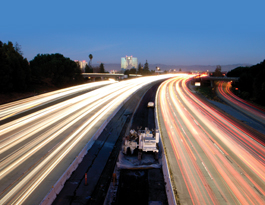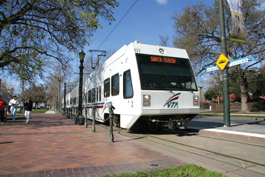home | metro silicon valley index | features | silicon valley | feature story

Photograph by Felipe Buitrago
Fueling the Fire
Hybrids and diamond lanes may be soothing our conscience, but they're not easing the transportation crisis. Will long-term solutions like mass transit ever get a real chance in our car-addicted culture?
By Erin Sherbert
In the 1940s, smoking was packaged and sold in advertisements displaying Santa Claus bringing Christmas cheer with a pack of Camels. Who would have thought that 50 years later we'd have local governments banning smoking in bars, parks and even your own apartment?Like cigarettes, once a symbol of sex and sophistication, cars have long been the cherished object of status, wealth and independence, a prized possession among Americans. And just like with cigarettes, we are slowly starting to choke on car culture.
But the surgeon general's alert on smoking wasn't enough to overcome smokers who were already hooked; so why would rising gas prices and global warming permanently void our devotion to cars? It took decades of grassroots campaigns and anti-cigarette movements to reverse the common perception of smoking. It will probably take the same for driving. Green guilt will only carry the environmentally minded driver so far. And commuter checks aren't enough to push the lightweight commuter over the edge.
Yet, the need for more mass transit is clear, as a growing number of commuters cross county lines to get to work.
So what will it take to tempt us back into mass transit?
"We put smokers on the fringe and that's had an impact," said Kent Bausman, associate professor of sociology at Maryville University in St. Louis. "You can follow the cigarette example, have ad campaigns demonizing cars, saying it's a bad steward of the environment."
While transportation agencies are touting the endless benefits of riding the bus, they are forgetting one important part of the equation: negative perceptions and social stigmas attached to mass transit, especially in suburban areas.
What transit needs is a progressive public relations campaign. Why not have ads with images of high-tech workers and college students riding mass transit, wrapped with environmentally conscious vignettes, Bausman said.
"This is ripe for the picking, to make mass transit look cool and a civic responsibility," Bausman said.
Auto Eroticism
In California, where congestion has reached critical levels, the majority of commuters would still rather drive alone. Last year, about 73 percent of California's commuters drove to work solo, while only 5 percent rode mass transit. That was when $2.50 a gallon was considered cheap and the average driver was spending almost two weeks a year stuck in traffic.
That flattens hope that escalating fuel prices, which are expected to reach $4 a gallon by next year, and hellish highway commutes will be enough to curb the car culture.
In fact, some studies are telling saying just the opposite. Mitch Baer, a public policy and environment graduate student at George Mason University in Virginia, recently surveyed more than 2,000 commuters in the Washington, D.C., area. He found that people who drove to work alone were more emotionally satisfied with their commute than those who rode public transportation or carpooled with others.
Even stuck in traffic jams, those commuters said they felt they had more control over their arrival and departure times as well as commuting route, radio stations and air conditioning levels.
Commuters said that driving alone was both quicker and more affordable, according to the study.
"They will have a tougher time moving people out of their cars," Baer said. "It's easier for most people to drive than take mass transit."
Part of the problem is that not everyone lives walking distance of public transit. They might get in their cars to drive to the station and say, 'Why not just drive to work,'" Baer said.
This is a real warning for policy makers who are hoping to shift those solo drivers into mass transit, Baer said. If people have the choice, they will drive. That means local governments need to think of ways to force commuters out of their cars, like limit parking. San Francisco voters this year shot down Proposition H, which would have allowed more parking in San Francisco.

Photograph by Felipe Buitrago
BEYOND THE BUS: The Valley Transportation Authority celebrated the 20th anniversary of its first light-rail line this week.
The Decline and Fall Of Public Transit
It was 1956 when former President Dwight Eisenhower created the federal Interstate system, a major turning point for American mobility.
It would be another 50 years before the United States saw record ridership on public transportation, with more than 10 billion trips in 2006.
The interstate system has become the Frankenstein monster of mobility, making it easier and quicker for people to get around by car, yet fueling traffic congestion and our reliance on cars.
The federal government has consistently spent millions every year on roads and highways since the early 1920s. It wasn't until the 1960s that public transportation received any federal funding.
The 1973 energy crisis was a boon for the beginning of many public transit systems in metro areas across the nation, including San Jose.
It had been more than two decades since the interstate highway system was first constructed. Cities had long paved over old rail lines and rights of way to make room for roads. Americans were basking in the comfort and convenience of their automobiles and they were enjoying low fuel prices, which averaged at 38 cents per gallon in California in 1973.
But the 1970s Arab oil embargo put new pressures on American drivers, forcing them to rethink the way they got around. It convinced them that maybe it was better to hop buses instead of wait in long gasoline lines. By 1980, California motorists were shelling $1.20 a gallon to fill their tank. There was a real fear of escalating fuel prices, prompting convincing studies where the merits of mass transit re-emerged.
Public policy began to take a new shape, with the federal government pumping millions into the public transportation system.
"The 1970s energy crisis logged attention to the need for alternative ways to transport people," said Larry Filler, president and CEO of TransitCenter, a New York–based nonprofit that works to provide commuter benefits. "Before that, most of the transportation funds were going to highways."
The Hybrid Trap
One by one, metro areas from Baltimore to San Jose started building light rails, subways and rapid transit systems. By 1975, San Jose had rolled out plans for its first light rail line through downtown, which opened in December 1987, attracting more than 350,000 riders the first year.
But by the 1990s, the spirit for mass transit tapered off as gas prices stabilized, transit funding was reprioritized and automakers built more fuel-efficient vehicles that encouraged driving.
Again, we rekindled our love for the comfort of our cars.
"We are still trying to think of a way to keep our cars—look at hybrids," Bausman said. "So I think that is the real uphill battle mass transit is facing."
Even today, roads and highways are getting a larger portion of government funding, making it difficult for transit agencies to give riders what they need: frequent bus transfers and convenient rail lines.
"It has to work into your lifestyle," said Virginia Miller, spokeswoman for the American Public Transportation Association. "If a bus only comes once an hour, it may not be convenient enough."
A New Hope?
But it takes money to add trains and increase bus frequency. In Sacramento, what we're getting instead is mixed messages.
Gov. Arnold Schwarzenegger last year signed off on A.B. 32, the most aggressive piece of "green" legislation aimed to cap greenhouse gases over the next two decades. A portion of that includes getting more people into transit and hybrids.
Yet, the state has continued to cut transportation funding, particularly public transit. Over the last six years, Legislatures have taken billions of dollars away from transportation to fund education, health care and other general budget needs.
Meanwhile, transit agencies have been limping on lean budgets, attempting to build its ridership with hopes for more frequent trains and better bus connections. Even massive, statewide projects have taken hits. The California High Speed Rail Authority has spent millions of dollars planning for a high-speed rail line from San Francisco to Los Angeles, but the plans have lagged along as funding has been on and off again.
More recently, the governor signed off on a budget that included cutting $1.3 billion from public transportation. The state also raided an account restricted for public transportation, prompting a lawsuit on behalf of the California Transit Association.
Public transit advocates are bracing themselves for more cuts next year, as the state faces a $10 billion budget deficit. But transportation faces an even bigger shortfall: $200 billion over the next decade.
The transportation crisis is so severe that voters are stepping in to cover the cost. California voters stepped in and last years passed a $20 billion bond for transportation. That is only one-tenth of the funding needed to fix our problems over the next decade.
Santa Clara County in 2000 passed Measure A, a half-cent sales tax for transportation, part of which is footing the largest portion of the bill to bring BART to Silicon Valley. We're still waiting for the rest of the funds from the state and federal government."There's too many projects chasing too few dollars," said Kurt Evans, government affairs manager with the Valley Transportation Authority, which operates Santa Clara County's light rail. "It's not as clear-cut as it was in the '80s; Now, you are cobbling together not one or two funding sources but eight, nine or 10 funding sources."It's going to take creative funding to get transit fully on track. Ironically, as more people are encouraged with carpool incentives to buy hybrids and other fuel-efficient cars, that means less gas tax coming in to fund transportation needs.
California has outpaced every other state in hybrid purchases. Here, hybrid drivers get access to the carpool lane. Now, transportation planners are working public-private partnerships into projects, and considering congestion pricing, where the price of driving would increase as congestion peaked.
"There has always been more money available for roadway than transit partly because there are more who use roads in the state than those who use transit," said Laura Stuchinsky, transportation director and land use with the Silicon Valley Leadership Group. "You can only get so much blood out of a turnip."
Still, some transportation experts believe there is a revival of transit happening, with communities looking for other ways to get around. In major cities that were only designed for cars, including Houston, Phoenix and Salt Lake City, drivers are now clamoring for public transportation. In 2004, Denver passed a $4.7 billion initiative to get better public transit and voters in Salt Lake City last year decided to tax themselves $2 billion to create a commuter rail that runs between the urban and suburban areas "It's like 'back to the future,'" said Miller sai d. "Before the car was dominant, people got around on public transportation on trolley and street cars."
Send a letter to the editor about this story.
|
|
|
|
|
|